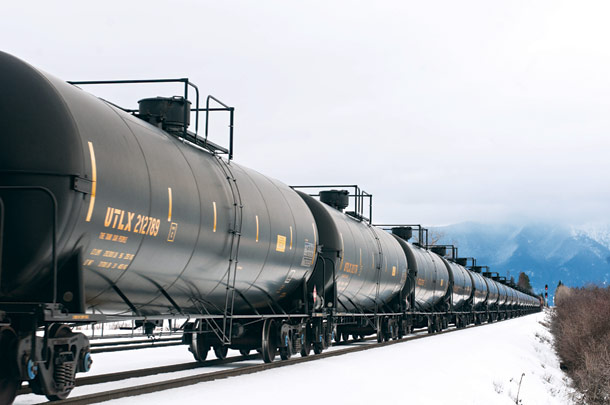The Flathead Basin Commission is asking the U.S. Department of Transportation to consider protecting cultural and environmental landmarks as the federal agency puts together new rules for the movement of crude oil by rail.
The commission made the motion during its biannual meeting in Pablo on Sept. 10. The action comes as more North Dakota crude oil is being moved along America’s rail lines, including on BNSF Railway’s line along Glacier National Park’s southern boundary.
“This issue needs a lot of attention,” said commission member and former Glacier superintendent Chas Cartwright. “Because it’s not just about protecting the beautiful Middle Fork of the Flathead River, it’s about protecting Columbia Falls, Whitefish and all of the other towns these oil trains go through.
“This is an issue that is not going to go away,” he added.
The movement of oil-by-rail has come under scrutiny after a series of high profile train wrecks in 2013 and 2014, including one in Quebec that leveled a downtown and killed 47 people.
In July, the U.S. Department of Transportation announced a series of proposed rules for the movement of crude oil, including phasing out the older, rupture-prone DOT-111 tank cars and reducing train speeds through populated areas. The rules could be implemented as early as this year, following a 60-day comment period.
“We’re suggesting that they look at reduced speed limits in special places like John Stevens Canyon (near West Glacier) because the Middle Fork of the Flathead River is a world-class resource,” Cartwright said.
The meeting in Pablo also included a presentation by Larry Peterman of the State Natural Resource Damages Program about the Yellowstone River oil spill in 2011 near Billings. According to Peterman, 63,000 gallons of crude spilled into the Yellowstone when a 12-inch pipe burst below the river. Because the river was already high, oil spread 90 miles downstream. Caryn Miske, executive director of the basin commission, said it was a “sobering” presentation.
“The take home message was that the pipeline spill was minor when compared to what a rail car spill could be,” she said.
Officials with BNSF have said they are prepared for such a spill and have put together a response plan specific to the Middle Fork of the Flathead River and the surrounding area.
Meanwhile, three national groups filed a lawsuit against the U.S. Department of Transportation for not doing enough to prevent oil train wrecks. On Sept. 11, the Sierra Club, ForestEthics and Earthjustice filed a joint lawsuit alleging that the DOT did not respond to a petition calling for the immediate phasing out of the DOT-111 tank cars.
“The Department of Transportation is gravely underestimating the risk of these cars,” said Patti Goldman, an attorney for Earthjustice. “More oil spilled in rail accidents in 2013 than the previous 37 years combined.”
While more oil spilled in rail accidents in 2013 than ever before, the rail industry still said that more than 99 percent of hazardous materials shipped by rail arrived at its destination without incident. The figure shows just how dramatic the rise in oil-by-rail has been in recent years. In 2008, Class 1 railroads, which include the largest rail companies in America, transported just 9,500 carloads of crude oil. Five years later, in 2013, they were projected to move more than 400,000 carloads.
